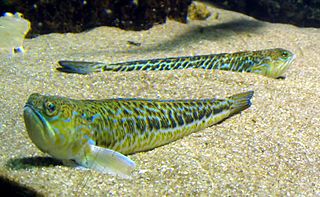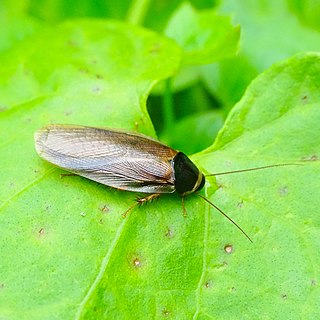
In taxonomy, binomial nomenclature, also called binary nomenclature, is a formal system of naming species of living things by giving each a name composed of two parts, both of which use Latin grammatical forms, although they can be based on words from other languages. Such a name is called a binomial name, a binomen, binominal name, or a scientific name; more informally it is also historically called a Latin name. In the ICZN, the system is also called binominal nomenclature, "binomi'N'al" with an "N" before the "al", which is not a typographic error, meaning "two-name naming system".

The skimmers, forming the genus Rynchops, are tern-like birds in the family Laridae. The genus comprises three species found in South Asia, Africa, and the Americas. They were formerly known as the scissorbills.

The curlews are a group of nine species of birds in the genus Numenius, characterised by their long, slender, downcurved bills and mottled brown plumage. The English name is imitative of the Eurasian curlew's call, but may have been influenced by the Old French corliu, "messenger", from courir , "to run". It was first recorded in 1377 in Langland's Piers Plowman "Fissch to lyue in þe flode..Þe corlue by kynde of þe eyre". In Europe, "curlew" usually refers to one species, the Eurasian curlew.

Sterna is a genus of terns in the bird family Laridae. The genus used to encompass most "white" terns indiscriminately, but mtDNA sequence comparisons have recently determined that this arrangement is paraphyletic. It is now restricted to the typical medium-sized white terns occurring near-globally in coastal regions.

Blattidae is a cockroach family in the order Blattodea containing several of the most common household cockroaches. Notable species include:

The oriental cockroach, also known as the waterbug or black cockroaches, is a large species of cockroach, adult males being 18–29 mm (0.71–1.14 in) and adult females being 20–27 mm (0.79–1.06 in). It is dark brown or black in color and has a glossy body. The female has a somewhat different appearance from the male, appearing to be wingless at a casual glance, but is brachypterous, having non-functional wings just below her head. She has a wider body than the male. The male has long wings, which cover three quarters of the abdomen and are brown in color, and has a narrower body. Both of them are flightless. The female oriental cockroach looks somewhat similar to the Florida woods cockroach and may be mistaken for it. Originally endemic to the Crimean Peninsula and the region around the Black Sea and the Caspian Sea, its distribution is now cosmopolitan.

Strombus is a genus of medium to large sea snails, marine gastropod molluscs in the family Strombidae, which comprises the true conchs and their immediate relatives. The genus Strombus was named by Swedish Naturalist Carl Linnaeus in 1758. Around 50 living species were recognized, which vary in size from fairly small to very large. Six species live in the greater Caribbean region, including the queen conch, Strombus gigas, and the West Indian fighting conch, Strombus pugilis. However, since 2006, many species have been assigned to discrete genera. These new genera are, however, not yet found in most textbooks and collector's guides.

Supella is a genus of cosmopolitan and wild cockroaches, in the family Ectobiidae: originating from Africa and the Arabian Peninsula.
Candidatus Rhabdochlamydia is a genus of intracellular bacteria and the sole genus in the family Candidatus Rhabdochlamydiaceae. As a Candidatus taxon, no-one has yet managed to culture them in vitro for deposition in a culture collection.

Periplaneta is a genus of cockroaches containing some of the well-known pest species with cosmopolitan distributions, such as:

Blaberus is a genus of cockroaches native to the Neotropics found in the Americas. More than 30 species are in the genus, and some of them are popular among hobbyists as pets or as feed for other arthropods. Unlike several genera of cockroaches considered to be pests, this genus keeps its ootheca in its abdomen until the time it hatches. They generally require a relative humidity of 60% or higher to thrive and temperatures above 25 °C to reproduce.

Trachinus is a genus of weevers, order Perciformes that consists of seven extant species. Six of the genus representatives inhabit the waters of Eastern Atlantic Ocean, but only one, Trachinus cornutus, inhabits the South-Eastern Pacific Ocean. Three of the Atlantic species occur near the coasts of Europe. An eighth extinct species, T. minutus, is known from Oligocene-aged strata from the Carpathian Mountains, while a ninth species, also extinct, T. dracunculus, is known from middle-Miocene-aged strata from Piemonte, Italy.
Orthopteroids are insects which historically would have been included in the order Orthoptera and now may be placed in the Polyneoptera. When Carl Linnaeus started applying binomial names to animals in the 10th edition of his Systema Naturae in 1758, there were few animals included in the scheme, and consequently few groups. As more and more new species were discovered and differences recognised, the original groups proposed by Linnaeus were split up.
In the 10th edition of Systema Naturae of 1758–1759, Carl Linnaeus classified the arthropods, including insects, arachnids and crustaceans, among his class "Insecta". He described the Insecta as:
A very numerous and various class consisting of small animals, breathing through lateral spiracles, armed on all sides with a bony skin, or covered with hair; furnished with many feet, and moveable antennae, which project from the head, and are the probable instruments of sensation.

Tettigonia is the type genus of bush crickets belonging to the subfamily Tettigoniinae. The scientific name Tettigonia is onomatopoeic and derives from the Greek τεττιξ, meaning cicada.

Ectobius is a genus of non-cosmopolitan cockroaches once thought native to the Old World and described by Stephens in 1835, belonging to the family Ectobiidae, subfamily Ectobiinae. The discovery of 4 ectobius cockroaches in Colorado dating to 49 million years ago suggests the genus actually originated in North America. This genus has been subject to a number of revisions.

Haemopis sanguisuga is a species of freshwater leech in the family Haemopidae. It is commonly called the horse-leech, but that is due to the similarity of its appearance to the leech Limnatis nilotica, which sometimes enters the nasal cavities of livestock. Haemopis sanguisuga does not behave in this way. Another synonym for this leech is Aulastomum gulo.
Shimwellia blattae is a species of bacterium, one of two in the genus Shimwellia. It is an aerobic enteric bacterium first isolated from the hindgut of cockroaches. Although it is related to human pathogens, including Escherichia coli, S. blattae is not pathogenic to humans. It is notable for its ability to synthesize vitamin B12 de novo.

Pycnoscelus is a genus of cockroaches in the family Blaberidae. Species in the genus Pycnoscelus are recorded from India, China and SE Asia.

Polyphaga is a genus of sand cockroaches in the family Corydiidae.
















